Food
Timbuktu has some of the best
cuisine in Mali. The people may also be the poorest but you
wouldn’t know it from the food. While the Moroccan invasion
was the start of the decline of Timbuktu it is also largely
responsible for the elegant architecture and savoury meals.
Although Timbuktu, like the rest of Mali depends on rice or
millet as its staple belly-filler it employes a much wider
range of spices. Click here for a description of the
of spices and herbs
used in
Timbuktu.
Here
is a description of several of the typical meals:
click
the name of the meal for a recipe
Alabadjia
a very traditional
nomad dish meat is cooked separated from its juices pounded
and liberally seasoned with the traditional butter called
Ghee, the meat juice is then added and the works is mixed
in with pre-cooked rice.
Assab or
Barghandi is a traditional nomad dish
made of millet pounded just enough to crack it and the hull
is removed. The rest is boiled and then served with a meat
and sauce.
Al Fitati Rice is pounded then the bater
made from it is spread thickly on the interior of a pot
heated over the fire. In only a few minutes it is cooked
and removed. This is served as a breakfast a small amount
of hot water is added to soften before it is eaten with
Ghee and honey. This is a very traditional dish that few
families in Timbuktu still make.
Al
Kefta, of Moroccan origin, consists of
small meatballs in sauce. The meat is de-boned and pounded
in a mortar with onions, garlic, bouillon and other spices
then rolled in to balls 1/2 inch or so in diameter cooked
in a frying pan with some oil and chopped onions etc. This
can be eaten with bread or put over rice.
Fokahoy a sauce made essentially of
the powdered leaves of the okra plant and shay butter
with a few other spices and some dried fish along with
the meat, served over white rice.
Gounday
Satakoray also easy and cheap, it is
rice and meat with only some onions, salt and black
pepper to flavour the rice.
Jissuma Gounday
is one of the
most common meals as it requires few ingredients and
less complicated cooking. It is a rice and meat dish
with the dried powdered leaves of the wild hibiscus
cooked in.

Maffay is a tomato based sauce of fourteen spices over white rice. The sauce may also contain a variety of vegetables depending on means and availability.
Maffay Tigidigi is a peanut butter based sauce over white rice. This dish comes from the south and they often make it as well or better there, but in Timbuktu they tend to add many of the other maffay spices that are ignored in the south.
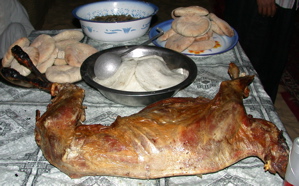
Tajeene is a sort of stew made typically at fetes and often accompanies the break-fast during Ramadan. It can be as simple as chunks of meat with some onion, black pepper and salt to more complicated additions of several other spices and cooked with chunks of sweet potato, split peas, or tinned mixed veggies. In other cases fries are added when serving. It is invariably sopped up with bread.
Toukasso this is a complicated but delicious dish made of balls of steamed bread covered in a tomato based sauce of the fourteen spices of Timbuktu.
Porridge
There are several kinds of boiled grain served as supper and or breakfast:
Bitta this is reference to varieties that do not have lumps. Those made with simple flour of either wheat, millet or occasionally rice. The flour is mixed to a smooth consitancy in a small amount of water then added to the pot of boiling water and cooked untill slightly thikened, the juice of a couple keylimes and some salt are added. It can be consumed thus or with milk and sugar added to taste. Another is prepared like barghandi only served as porridge.
Money refers to varrieties of porridge that do have lumps. Two main types of this are prepared. One using only flour wherein a portion of the flour is moistened and mixed with the hand to form small balls which are cooked first then the rest of the flour is added as with bitta. Another variety uses a locally popular pasta produced in Algeria that are bee-bee sized pellets these are added to boiling water in place of the balls of flour. When the other flour added to thicken it is cooked lime juice is added. Again it can be sweetened and milk added to taste.
Mo serie This is yet another variety of porridge made with rice, usually broken grains are cooked until very soft in an excess of water so it is still pourable. Sweetened slighlty with milk added preferably one of the thickened soured yougurt like milks.
Breads
Tadjala is the traditional bread of the nomads. It is made of wheat semolina flour, water and a dash of salt. Cooked in the sand, by first building a fire to heat the sand then moving the fire to the side and scraping off the blackened sand, the dough is placed on clean sand and covered by more sand. The fire is replaced on top and tea is prepared while the dough cooks. When it is done a few hearty whacks knocks off the sand clinging to the outside. The bread is then broken into bits and served with a sauce or with honey and butter.
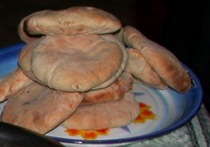
Widjila is basically the bread of the toukasso only steamed only in plain water it is consequently white in colour, the outside is dry and it seams slightly less dense.
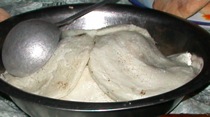
Snacks
Al Helewa comes from the arabic word for sweet or sugar. This is a form of cooked pulled sugar that is solidified into long twists about as thick as an average candy cane and broken into two inch lengths.

Furmi or Benginers, in French, are fried dough balls about the size and shape of doughnut holes they are usually made of a simple bread dough that has not been thicken to kneading consistancy the sloppy batter can just be manipluated with the hands and blobs are dropped in hot oil and fried.
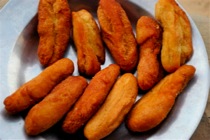
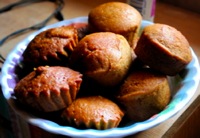
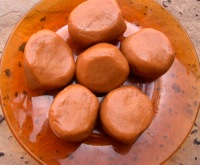
Jujube This wild fruit, in addition to being eaten as is, is dried and pownded till the fruit portion can be separated and is then compressed in to disks.
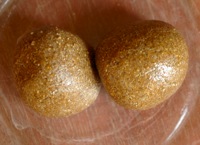
basically a peanut brittle

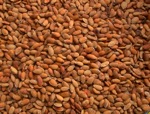
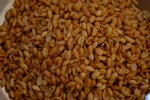
Drinks
Ataye this is the green tea drunk all over western Africa. It may vary in concentration (typically the farther south you go the more concentrated it gets), but it is the same in essentials. The tea is always served in a series of three progressively sweeter and weaker cups. This is because the same leaves are re-boiled for each glass. The tea is placed loose in a small pot with the water to serve the number of people to be drinking. It is boiled on a charcoal stove, sugar is added and it is poured from glass to glass and back into the pot in a sometimes dramatic display of dexterity. This mixes and cools the tea and creates an aesthetically pleasing foam in each glass, the outside of which is rinsed and then tea is served. There are some general rules about serving. Often the most respected are served first, thus oldest and any guests. Otherwise it goes counter-clockwise starting at the right of the tea maker. There are usually only 2 or 3 small glasses that look like large shot glasses, filled half-full. You are not obliged to drink the entire thing if you don’t want. When finished the glass is refilled and given to the next person. When all have drunk, more water is added and the process begins again. The time to complete this ritual varies depending on how badly the drinkers want a shot of caffeine and what else they have to do. Once you have drunk the first glass it is best to stay for the second but you don’t have to take the third. Conversely you can decline the first, saying it is too strong. But then accept the second and third. Tea is so much more than a beverage in this society it is the essence of welcome good-will and hospitality. In the desert offering someone tea is equivalent of offering a peace pact.
Doughgana or Done in Songai and “Creme” when they speak French is a beverage made of millet flour, powdered baobab, powdered melon seeds, some local rice, hot pepper, and some other spices which can include cumin, anise, wangara maffe je, fefe and salt. To make it more creamy people will pound up the hard (dry) goat cheese and add this as well. This hardy drink is often a late morning snack. For caravaners, who don’t stop the march till the end of the day, it is lunch. With a good mix of nutrients and a high calorie content it keeps up the energy - a bit like trail mix. Many families make it from scratch having a pounded a quantity of the various ingredients to powders in advance. It is sold in the market in golf ball sized lumps that have been lightly mixed with water to hold it together. These do not store well but are convenient for immediate use.
Jiisuma chiray called bisap in French made from the petals of a red hibiscus flower soaked or steeped to extract the flavour then strained and diluted and sweetened to taste. They often add a bit of ginger as well to make it piquant.
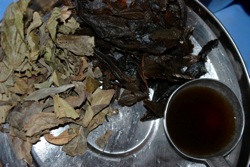
Kohaamny often called pain-de-singe in French and its translation Monkey Bread in English, this is made of the fruit of the baobab tree. The seeds and all are soaked until the fruit is dissolved or a pre-powdered fruit is used. The bits of fibre or seed are strained out and it is diluted and sweetened to taste. Baobab fuit is actually quite nutritious with a high content of vitamins, minerals and essential amino acids. Like bisap this often has ginger added or today Foster Clarks mix.
Limonharri a sort of gingeraide made with ginger and lemon juice diluted and sweetened to taste.
Zrig, this is a catchall for sweetened diluted milk drinks. The milk can be fresh, soured, reconstituted from powder or concentrate, from cow, goat, sheep, or camel. Some people add some vanilla sugar for flavour some sweeten with honey. The men sometimes make a sort of medicine from it that is supposed to give strength it includes adding hot pepper and powdered seeds of a certain plant.